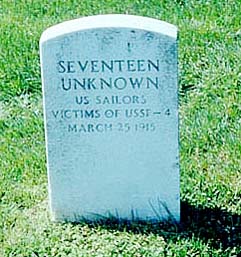Advertisement - Click to support our sponsors.


Sub veterans’ group
By Burl Burlingame
working to save
historic headstone
Star-BulletinEighty-five years ago, the Navy's first underwater disaster occurred when the submarine F-4 exploded and sank off Honolulu Harbor. This summer, the headstone marking the common grave of 17 sailors from the F-4 will be destroyed unless a new site for it is found in Hawaii.
F-4 was one of the first submarines assigned to the new naval facility at Pearl Harbor in the years prior to World War I. On March 25, 1915, the submarine vanished on routine patrol, and was later discovered a mile off Fort Armstrong, 300 feet underwater.
No one had ever salvaged a vessel from such a depth before, and Navy attempts proved fruitless for several months. One diver was later awarded the Medal of Honor for rescuing another diver at the crushing depths. Finally, using specially constructed pontoons, the submarine was raised on Aug. 31, 1915 and towed to Pearl Harbor.

After so many months underwater, only four of the 21 dead aboard the submarine could be identified. The 17 remaining bodies were sealed in four caskets and shipped to Arlington National Cemetery, where they were buried in a common grave. The headstone, the size of an individual marker, is marked simply "17 Unknown U.S. Sailors Victims of the USS F-4 March 25 1915."United States Submarine Veterans Inc. convinced Arlington to replace the simple headstone with a more appropriate group headstone, which will occur later this summer. But to the horror of one of the group's officials, Richard Mendelson, who spearheaded the campaign, cemetery rules are strict about the disposition of old headstones -- they are sent to the rock crusher and destroyed.
"The idea is because people were stealing headstones and using them as paving stones and coffee tables and whatnot," said Mendelson from Virginia. "But this stone is a historic artifact itself, and should really be placed in Hawaii."
Mendelson met with Arlington supervisor John Metzler and historian Thomas Sherlock last Friday and the cemetery officials were sympathetic but firm. A loophole emerged, however: The stones can be transferred to another government facility.
"I immediately thought of the Punchbowl cemetery, and the Submarine Base, and the Bowfin Museum. It's particularly appropriate because this year is the 100th anniversary of the U.S. Navy's submarine service," said Mendelson.
The headstone is fairly small, a standardized individual marker that Arlington's own quarry still makes at the rate or 25 to 30 a day. "It's so small it took us a year to find it in Arlington," chuckled Mendelson.
The USS Bowfin Submarine Museum & Park has already written Metzler, requesting that the headstone be spared destruction and placed under the museum's care. The museum, a private organization on Navy property, already has exhibits and archives on the fate of the F-4.
Executive Director Gerald Hofwolt concludes in his letter that Bowfin will be unveiling a plaque on June 30 dedicated to submarine crews lost prior to World War II, and that "in this centennial year of the U.S. Submarine Force, I can think of no more fitting gesture of support than to honor the gallant men of the earliest days of submarine warfare by appropriate display of the headstone of the USS F-4 in a memorial setting."
Punchbowl National Memorial Cemetery's Alan Sumitomo, support-services supervisor, said there is likely not a proper location in the cemetery.
"All of our headstones actually mark gravesites," he said, and confirmed that the rock-crushing rule applies to all national cemeteries. "Otherwise, you'll see headstones in people's yards."
Lt. Cmdr. Dave Werner, Submarine Base public-affairs officer, said his division is quite interested in talking to Mendelson.
"Ironically, we're just about to start quite a lot of maintenance on the Sierra 14 pier, where there's a plaque commemorating the F-4," said Werner.
Alongside or beneath the submarine base pier is the last known resting place of the F-4. Refloated by the Navy in 1915, it was used as a harbor marker until 1940, when the Navy scuttled the hull to make way for new construction. Periodically since, the Navy has announced plans to either destroy or examine the F-4 -- the oldest surviving U.S. Navy submarine -- but because of the deep silt in Pearl Harbor, the exact location is unknown.